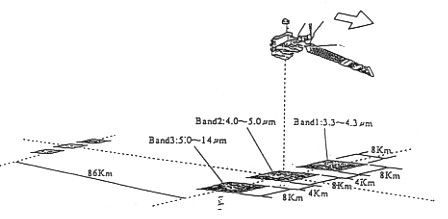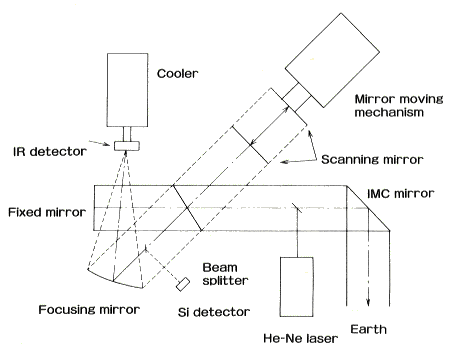


|
| IMG Observation Concept |
The Interferometric Monitor for Greenhouse Gases (IMG) is a sensor to monitor the earth's radiation balance, the temperature profile of the atmosphere, the temperature of the earth's surface, and physical properties of clouds. It was developed by the Japan Resources Observation System Organization (JAROS) for the Ministry of International Trade and Industry (MITI).
IMG will obtain detailed spectra of thermal infrared radiation from the earth's surface and atmosphere. The detailed spectra measared by the IMG will be used to infer atmospheric concentrations of water vapor and other greenhouse gases.
A global increase in tropospheric concentrations of trace gases, such as carbon dioxide, methane, nitrous oxide, and chlorofluorocarbons (CFCs) has been noted. These increases have been brought about by human activities. Now however we have limited knowledge of the magnitude or distribution of the anthropogenic sources of these gases. Two sources whose magnitude must be investigated are deforestation and biomass burning. IMG will map the global and regional distribution of emission sources by measuring variations in the concentrations of trace gases.
Moreover, natural sources and sink strengths of trace gases may vary widely with different terrestrial and oceanic ecosystems.
| Spectral Range of Measurement | 714-303 cm (14 - 3.3um) |
|---|---|
| Wave number resolution | 0.1cm (apodized) |
| Absolute accuracy of measurement | < = 1k |
| Stability of measurement | <= 0.1k |
| Interferogram scan time | <= 10sec |
| Sampling per intergerogram | <= 100,000 |
| Mass | < 115kg |
| Power consumption | < 150w |
| Approximate Size | within 1000x800x500mm |
IMG is a Michelson-type Fourier Transform Spectrometer (FTS) with two mirrors and a beam splitter. The incident radiation received from the earth is devided by the beam splitter into two paths. One mirror is moved so that the two paths produce an interference pattern when they are recombined. The signal measured by the detector, the interferogram, can be Fourier transformed to obtain the incident spectrum. The diameter of the entrance aperture for the optics is 10cm. The moving mirror is suspended on magnetic bearings and scans a 10 cm long path in 10 seconds.

|
| IMG Optical System |
Comments to: adeossupport@eorc.nasda.go.jp
Last Update: 11 November 1996